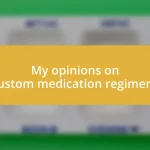Key takeaways:
- Living with hemophilia requires constant vigilance and emotional support, as daily life is impacted by symptoms, management routines, and the need for community connections.
- Regular medical care is crucial for monitoring health, preventing complications, and providing education on self-care techniques related to hemophilia management.
- Coping strategies, including staying calm during bleeding episodes, utilizing support networks, and keeping a detailed log of episodes, play a significant role in managing the challenges of hemophilia.

Living with hemophilia overview
Living with hemophilia presents a unique set of challenges that permeate daily life. I remember discovering my diagnosis as a child, which felt like a heavy weight on my shoulders. How do you explain to friends why you can’t join in on certain activities or why you need to be extra careful?
Managing hemophilia requires constant vigilance, and this can sometimes lead to anxiety. I’ve often found myself double-checking the playground for hazards before letting my child play, a habit I developed over years of being cautious. It’s a dance between wanting to embrace life fully and needing to respect the limits that come with this condition.
Beyond the physical impact, there’s an emotional journey that accompanies hemophilia. I’ve had moments of feeling isolated due to my restrictions, but I also found community in support groups. Have you ever felt that connection with others who understand your journey? Those shared experiences often remind me that I’m not alone, creating a powerful bond in navigating this life together.

Understanding hemophilia symptoms and causes
Understanding hemophilia involves recognizing its main symptoms, which often manifest as prolonged bleeding and easy bruising. I recall one time as a teenager when a simple bump while playing basketball turned into an unexpected visit to the emergency room, leaving me both scared and frustrated. It’s not just about the physical bleeding, but also the emotional toll it takes — the fear of injury that can keep you on the sidelines even when you want to be in the game.
Key symptoms of hemophilia include:
- Prolonged bleeding from cuts or injuries
- Frequent nosebleeds without a clear cause
- Excessive bruising from minor bumps
- Joint pain and swelling due to internal bleeding
The underlying causes of hemophilia primarily relate to genetic factors, specifically a deficiency in clotting factors. This deficiency can be inherited, which means that knowing my family history has been crucial. For instance, I learned that my maternal uncle also had hemophilia, highlighting its genetic footprint in my family. Recognizing these triggers has been vital not just for my health, but also for educating my loved ones about the importance of carefulness in settings where injuries could occur.

Importance of regular medical care
Maintaining regular medical care is absolutely crucial for anyone living with hemophilia. I can’t stress enough how important it is to keep up with my specialist appointments and follow treatment plans. Each visit doesn’t just help manage my condition; it also offers reassurance. I recall one appointment where my doctor adjusted my dosage based on recent blood tests, which made a significant difference in my daily life. It’s a proactive approach that can really prevent complications down the road.
Regular check-ups allow for ongoing monitoring of clotting factor levels. This information helps in planning physical activities while minimizing the risk of bleeding episodes. There was a time when I underestimated this aspect and ended up with a painful joint bleed after basketball practice. I had thought I could push through without consulting my team, but it taught me to prioritize these sessions as essential—like fueling a car before a long journey.
Additionally, routine medical care opens the door for education. I often come away from these visits with new strategies for self-care and blood management. For instance, my last appointment included a workshop on recognizing early signs of a bleed, which significantly reduced my anxiety about potential injuries. Have you experienced a similar transformation through regular medical attention? It can really empower you to take control of your health.
| Benefits of Regular Medical Care | Consequences of Neglecting Medical Care |
|---|---|
| Ongoing monitoring of clotting factors | Increased risk of severe bleeding episodes |
| Adjustment of treatment plans | Potential for serious joint damage |
| Access to education on self-care | Feelings of helplessness and anxiety |

Daily routines for managing hemophilia
Establishing a daily routine is essential for effectively managing hemophilia. For me, it starts every morning with a blood factor infusion before breakfast. I remember the first time I had to do it; I was nervous about the process and how my body would react. But, over time, it became a normal part of my life, almost like brushing my teeth. Getting used to this routine not only helps ensure I stay within a safer range of clotting factors but also gives me a sense of control over my condition.
In addition to my infusions, I make a point to incorporate gentle exercises. I’ve learned that while I want to stay active, high-impact sports can lead to injuries. A few months ago, I tried a new yoga class focused on balance and flexibility, which, surprisingly, became my favorite. Have you considered how certain activities might fit into your daily routine? It’s about finding that sweet spot where you can enjoy movement without risking injury.
On days when I feel a bit anxious about potential bleeds, I’ve found it helpful to carry a care kit with me. This kit includes essential supplies, like band-aids and ice packs, just in case. One day, I had a minor scrape while gardening, and because I was prepared, I managed to treat it immediately without any panic. Having these routines not only keeps me physically safe but also calms my mind, allowing me to focus on enjoying life—after all, isn’t that what we all want?

Coping strategies for bleeding episodes
When faced with a bleeding episode, my go-to strategy is to stay as calm as possible. In the heat of the moment, I’ve found that taking deep breaths and assessing the situation helps. I remember a time when I accidentally bumped my knee against a sharp edge. Instead of panicking, I paused, checked for bleeding, and applied pressure while also reaching for my factor medication. This approach turned a potentially overwhelming experience into something manageable. Have you ever found yourself in a similar situation?
Another coping mechanism I rely on is having a strong support network. My family and friends have been invaluable in tough moments. Just last month, during a lengthy hike, I experienced unexpected swelling in my ankle. I texted my brother immediately, and his quick response helped ease my anxiety. Sharing these moments not only alleviates stress but also ensures I have someone to lean on if complications arise. Are there people in your life you turn to when things get challenging?
Lastly, keeping a detailed log of my bleeding episodes has proven to be incredibly helpful. After each incident, I jot down what triggered it, how I responded, and any factors that seemed to elevate my risk. This log doesn’t just serve as a record; it’s an educational tool that reveals patterns. I noticed that on days when I was fatigued, I was more prone to bleeding. This insight has encouraged me to prioritize rest and listen to my body. Have you considered tracking your experiences? You might uncover surprises that could improve your self-care practices.

Emotional support and community resources
Emotional support plays a pivotal role in managing the challenges that come with hemophilia. I remember the first time I attended a local support group meeting. Walking into a room filled with people who understood my struggles was surprisingly comforting. It was like finding a piece of my puzzle—these shared experiences helped me realize I wasn’t alone. Have you ever had that moment where you finally connect with others who truly understand your journey?
Beyond personal connections, community resources can provide invaluable assistance as well. I’ve leaned on organizations dedicated to hemophilia for both information and emotional support. They offer everything from educational workshops to online forums where members share strategies for coping. One night, while feeling overwhelmed, I logged onto an online chat with someone who had been in my shoes. Their insights and encouragement lifted my spirits and made me realize the strength that lies in community. Isn’t it amazing how a few words from a stranger can change your entire outlook?
Navigating the emotional landscape of living with hemophilia requires ongoing effort. I make it a habit to prioritize my mental health—whether through mindfulness meditation or simply taking a stroll in the park. Each time I engage in these practices, I feel more grounded and focused. Recently, I had a session where I visualized a future where I could enjoy life’s adventures confidently, without being held back by my condition. This exercise sparked a sense of hope within me. Have you identified any specific practices that help bolster your emotional resilience?














